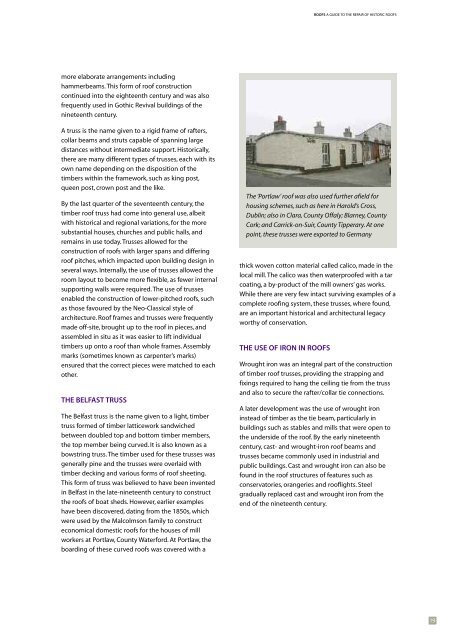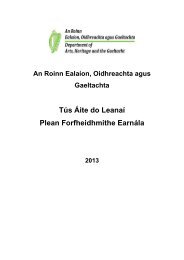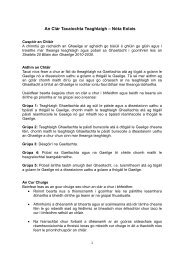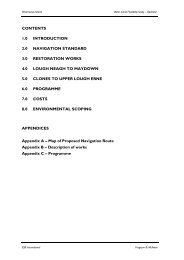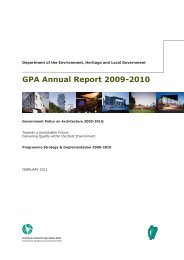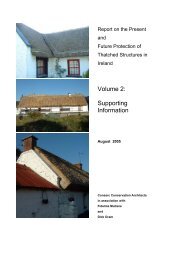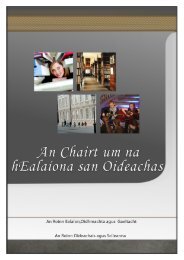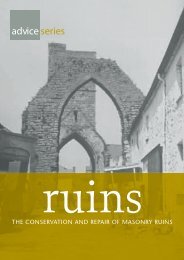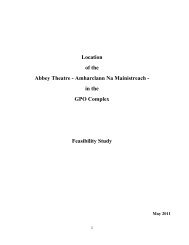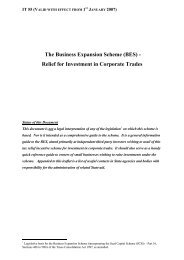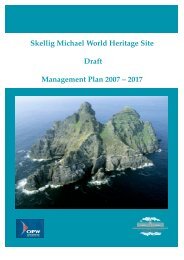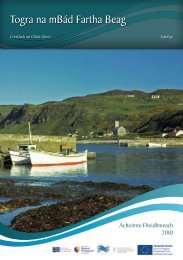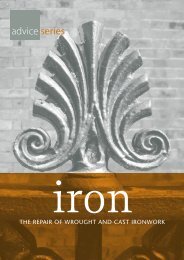A Guide to the Repair of Historic Roofs - Dublin City Council
A Guide to the Repair of Historic Roofs - Dublin City Council
A Guide to the Repair of Historic Roofs - Dublin City Council
You also want an ePaper? Increase the reach of your titles
YUMPU automatically turns print PDFs into web optimized ePapers that Google loves.
ROOFS A GUIDE TO THE REPAIR OF HISTORIC ROOFSmore elaborate arrangements includinghammerbeams. This form <strong>of</strong> ro<strong>of</strong> constructioncontinued in<strong>to</strong> <strong>the</strong> eighteenth century and was als<strong>of</strong>requently used in Gothic Revival buildings <strong>of</strong> <strong>the</strong>nineteenth century.A truss is <strong>the</strong> name given <strong>to</strong> a rigid frame <strong>of</strong> rafters,collar beams and struts capable <strong>of</strong> spanning largedistances without intermediate support. His<strong>to</strong>rically,<strong>the</strong>re are many different types <strong>of</strong> trusses, each with itsown name depending on <strong>the</strong> disposition <strong>of</strong> <strong>the</strong>timbers within <strong>the</strong> framework, such as king post,queen post, crown post and <strong>the</strong> like.By <strong>the</strong> last quarter <strong>of</strong> <strong>the</strong> seventeenth century, <strong>the</strong>timber ro<strong>of</strong> truss had come in<strong>to</strong> general use, albeitwith his<strong>to</strong>rical and regional variations, for <strong>the</strong> moresubstantial houses, churches and public halls, andremains in use <strong>to</strong>day. Trusses allowed for <strong>the</strong>construction <strong>of</strong> ro<strong>of</strong>s with larger spans and differingro<strong>of</strong> pitches, which impacted upon building design inseveral ways. Internally, <strong>the</strong> use <strong>of</strong> trusses allowed <strong>the</strong>room layout <strong>to</strong> become more flexible, as fewer internalsupporting walls were required. The use <strong>of</strong> trussesenabled <strong>the</strong> construction <strong>of</strong> lower-pitched ro<strong>of</strong>s, suchas those favoured by <strong>the</strong> Neo-Classical style <strong>of</strong>architecture. Ro<strong>of</strong> frames and trusses were frequentlymade <strong>of</strong>f-site, brought up <strong>to</strong> <strong>the</strong> ro<strong>of</strong> in pieces, andassembled in situ as it was easier <strong>to</strong> lift individualtimbers up on<strong>to</strong> a ro<strong>of</strong> than whole frames. Assemblymarks (sometimes known as carpenter’s marks)ensured that <strong>the</strong> correct pieces were matched <strong>to</strong> eacho<strong>the</strong>r.THE BELFAST TRUSSThe Belfast truss is <strong>the</strong> name given <strong>to</strong> a light, timbertruss formed <strong>of</strong> timber latticework sandwichedbetween doubled <strong>to</strong>p and bot<strong>to</strong>m timber members,<strong>the</strong> <strong>to</strong>p member being curved. It is also known as abowstring truss. The timber used for <strong>the</strong>se trusses wasgenerally pine and <strong>the</strong> trusses were overlaid withtimber decking and various forms <strong>of</strong> ro<strong>of</strong> sheeting.This form <strong>of</strong> truss was believed <strong>to</strong> have been inventedin Belfast in <strong>the</strong> late-nineteenth century <strong>to</strong> construct<strong>the</strong> ro<strong>of</strong>s <strong>of</strong> boat sheds. However, earlier exampleshave been discovered, dating from <strong>the</strong> 1850s, whichwere used by <strong>the</strong> Malcolmson family <strong>to</strong> constructeconomical domestic ro<strong>of</strong>s for <strong>the</strong> houses <strong>of</strong> millworkers at Portlaw, County Waterford. At Portlaw, <strong>the</strong>boarding <strong>of</strong> <strong>the</strong>se curved ro<strong>of</strong>s was covered with aThe ‘Portlaw’ ro<strong>of</strong> was also used fur<strong>the</strong>r afield forhousing schemes, such as here in Harold’s Cross,<strong>Dublin</strong>; also in Clara, County Offaly; Blarney, CountyCork; and Carrick-on-Suir, County Tipperary. At onepoint, <strong>the</strong>se trusses were exported <strong>to</strong> Germanythick woven cot<strong>to</strong>n material called calico, made in <strong>the</strong>local mill. The calico was <strong>the</strong>n waterpro<strong>of</strong>ed with a tarcoating, a by-product <strong>of</strong> <strong>the</strong> mill owners’ gas works.While <strong>the</strong>re are very few intact surviving examples <strong>of</strong> acomplete ro<strong>of</strong>ing system, <strong>the</strong>se trusses, where found,are an important his<strong>to</strong>rical and architectural legacyworthy <strong>of</strong> conservation.THE USE OF IRON IN ROOFSWrought iron was an integral part <strong>of</strong> <strong>the</strong> construction<strong>of</strong> timber ro<strong>of</strong> trusses, providing <strong>the</strong> strapping andfixings required <strong>to</strong> hang <strong>the</strong> ceiling tie from <strong>the</strong> trussand also <strong>to</strong> secure <strong>the</strong> rafter/collar tie connections.A later development was <strong>the</strong> use <strong>of</strong> wrought ironinstead <strong>of</strong> timber as <strong>the</strong> tie beam, particularly inbuildings such as stables and mills that were open <strong>to</strong><strong>the</strong> underside <strong>of</strong> <strong>the</strong> ro<strong>of</strong>. By <strong>the</strong> early nineteenthcentury, cast- and wrought-iron ro<strong>of</strong> beams andtrusses became commonly used in industrial andpublic buildings. Cast and wrought iron can also befound in <strong>the</strong> ro<strong>of</strong> structures <strong>of</strong> features such asconserva<strong>to</strong>ries, orangeries and ro<strong>of</strong>lights. Steelgradually replaced cast and wrought iron from <strong>the</strong>end <strong>of</strong> <strong>the</strong> nineteenth century.19


